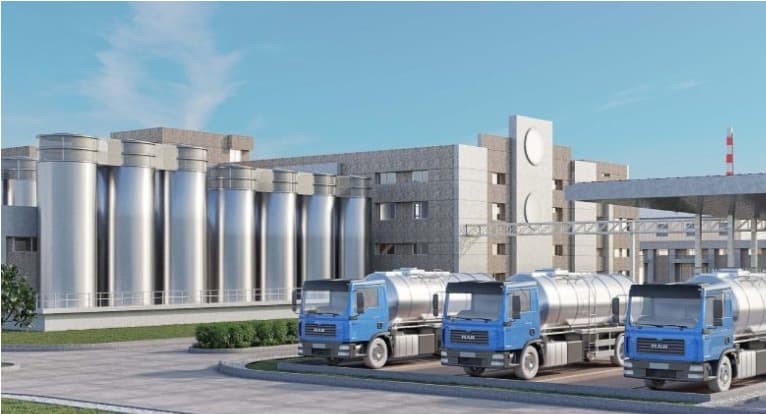FSSAI issues guidelines for Primary milk producers
FOOD SAFETY AND STANDARDS AUTHORITY OF INDIA NOTIFICATION New Delhi, the 3rd October, 2024 F.No. RCD-01002/1/2021-Regulatory-FSSAI-Part(2).—
Primary Milk producers
Specific considerations for primary milk producers including small dairy holders who are not members of any dairy cooperative societies and involved in producing milk and offering for sale for direct human consumption without any processing.
‘Primary production of milk’ refers to the practises where milking machines are not generally used, raw milk is not chilled at the producer’s level and /or the raw milk is transported in cans, if the same is distributed to consumers, doorto-door by the producer itself. In order to reduce the likelihood of milk contamination through inadequate primary production practises, the dairy operators should conform to the sanitary and hygienic requirement, food safety measures and other controls as specified below:Environmental Hygiene-
(i) Cow-Shed: The stables and barns should be clean, well ventilated and well lighted. Ensure proper drainage of dung and urine directly to the sewer or frequent removal, following the guidelines prescribed by the local authority. (ii) Good housing and manure disposal system should be assured. (iii) Feed & Water: Feeds giving off flavour should be avoided. The quality of water used at farm for different purposes such as cleaning of the udder, for cleaning equipment used for milking and storage of milk should be of satisfactory quality. Hence, clean potable water supply should always be available. Measures shall be taken to ensure that Milking animals do not consume or have access to contaminated water or other environmental contaminants likely to cause diseases transmissible to humans or contaminate milk.As far as may apply, ‘’Guidelines for Environmental Management of Dairy Farms and Gaushalas’’ issued by local authority may be followed.
Hygienic production of milk-
(i) Animal Holding Area- Holding area should be kept clean and free from accumulations of manure, mud or any other objectionable materials and maintained in a manner that minimizes the risk of animal infection or contamination of the milk. Such area should not adversely affect the health of animals, in particular, the litter and the stabling area should be maintained in a manner that minimizes the risk of teat injuries and udder diseases. (ii) Milking areas and related facilities- Should be kept free from undesirable animals e.g, pigs, poultry a d other animals whose presence may result in the contamination of milk. The premises should be easy to clean, especially in areas subject to soiling or infection. They should have flooring constructed to facilitate draining of liquids and adequate means of disposing waste. Should have adequate supply of potable water for use when milking and in cleaning the udder of the animals and equipment used for milking. The area should have effective separation from all sources of contamination such as manure heaps. (iii) Animal Health- Adequate management measures should be implemented to prevent animal diseases or control of risk of transmission of the diseases and to control drug treatment of diseased animals in consultation of local authority/ veterinarian. The milk should originate from animals free from systemic diseases whose causative agents such as Mycobacterium tuberculosis, Coxiella burnetti, Brucella abortus, which can be transmitted to man through milk. The animals should also be free from bacterial diseases such as salmonellosis, anthrax, shigellosis, enteropathogenic E.Coli, Streptococcus and other bacterial infections and viral infections such as vaccinia, pseudo cowpox, louping ill (Tick borne encephalitis), food & mouth diseases etc. Milk should be drawn from animals that do not show visible impairment of the general state of health and which are not suffering from any infection of the genital tract with discharge, enteritis with diarrhoea and fever, or recognizable inflammation of the udder. If not officially free, then the milk should originate from herds or animals that are under official control and eradication programmes as provided by the local authority.(iv) Veterinary Drugs-Good husbandry procedures should be used to reduce the likelihood of animal diseases and thus reduce use of veterinary drugs. Only those veterinary drugs that have been authorized by the competent authority for inclusion in animal feed or direct administration (oral/injections) should be used. Always discard the milk from the animal treated with antibiotics for the prescribed days, as the milk may have antibiotic residues that may affect the quality of the milk or health of a consumer. It is preferred that the animals shall be declared to the competent authorities and registered. (v) Hygienic Milking-The milking animals should be maintained in as clean state as possible. Natural process of milking shall be followed. Forceful milking with inhumane practises like oxytocin shall be prohibited. Udder should be cleaned before milking. If the calf is used for excitation, wash the udder after suckling also. Separate utensils are recommended for washing of udder and for milking. Initial few strips of milk (foremilk) should be thrown out. Always ensure complete milking as the microbes will grow on the left over milk in udder resulting in mastitis. Disinfect the teats by teat dip (i.e. disinfectants, iodophor etc.) after milking, to restrict entry of microbes to the teat canal. Effective hygienic practises be applied in respect of the skin of animal, the milking equipment (if and whenever used), the handler and general environment e.g, faecal sources of contamination.Good hygiene is essential whether the animals are milked by hand or machine. This requires; (i) Good personal hygiene of the milking personnel (ii) Clean udders, teats, groins, flanks and abdomens of the animals (iii)Clean and disinfected milking vessels/equipment & (iv)Avoidance of any damage to the tissue of the teat/udder Feeding of the animals or placement/removal of litter should be avoided while milking in order to reduce the likelihood of contamination of the milking equipment and the milking environment from manure or dust. Milking operations should minimize the introduction of food borne pathogens and foreign matter from skin and general milking environment as well as chemical residues from cleaning & disinfection routines.
(vi) Milking Equipment & Cans- Milking equipment, utensil intended to come into direct contact with milk should be designed and maintained in such a way that they can be adequately cleaned, corrosion resistant, and not capable of transferring substances to milk in such quantities as to present a health risk to the consumer. There shall be no dent, cracks, crevices or recesses that can interfere with proper cleaning. Cleaning & disinfection should be done regularly and with sufficient frequency. The equipment should be designed such that it does not damage teats and udder during normal operation. These equipment and cans should be preferably made up of non-rusting and non-absorbent materials such as Stainless steel, galvanized iron or aluminium. Never use paper, cloth etc. to air tight the lid of the milk can. Milk cans should not be used to store any harmful substance that may subsequently contaminate milk. Milk tanks and cans be used only to store milk and milk products. (vii) Health and personnel hygiene of milking personnel- Milking personnel should be in good health. Hands & forearms (up to elbow) should be washed frequently and always washed before initiating milking or handling of milk. Suitable clothing should be worn during milking. Milking should not be performed by person having exposed abrasions or cuts on their hands or forearms. Any injury must be covered with water –resistant bandage. Individuals suspected to be suffering from, or to be carrier of, diseases likely to be transmitted to the milk, should not be milking the animals. Milker should be free from contagious diseases like cholera, typhoid, diphtheria and tuberculosis and should be monitored for these diseases rigorously on regular basis.
Handling, storage and transportation of milk-
Generally, animals are milked at least twice a day. The milk is distributed to the consumers within 3-4 hours of milking from such dairies. If could not distribute completely and is to be kept for later distribution, the milk shall be stored in suitable refrigeration at 4-6 °C. Premises for the storage of milk should have adequate separation between milking areas and any premises where animals are housed in order to prevent contamination of milk by animals. Where separation is not possible, adequate measures should be taken to ensure that the milk is not contaminated. In situations where the milk cannot be chilled on the farm, collection and delivery of this milk to a collection centre of processing facility within certain time limits, preferably within 04 hours from milking) may be required. The quality of milk will deteriorate during transit, if the surfaces that are in contact with milk are not sufficiently clean and milk is at high temperature supporting the growth of microbes.
Dairy Sanitation –
(i) Proper sanitation of milk cans - Immediately after cans are emptied of milk they should be cleaned as follows: (a) Cold water rinse. (b) Scrubbing with brush and warm detergent (any unperfumed liquid soap will do). (c) Cold water rinse. (d) Sterilization (sanitisation) with boiling water or steam if available or use dairy sanitising solution such as hypochlorite or commercial brand preparations in accordance with manufacturer's instructions. (e) Dry cans on a drying rack. Exposure to sunlight will enhance killing off bacteria during drip drying of cans. (ii) Milking MachinesIf milking machines are used for milking other than the conventional thumb milking, proper cleaning and sanitation of the same shall be done after each use according to recommended practice: (a) Cold Water rinse. (b) Hot water rinse. (c)Timely replacement of worn out rubber parts should be undertaken regularly. (3) in Schedule 4, after part III related to ‘Milk and Milk Products’, the following sub-part shall be inserted, namely: - PART III(a) Primary Milk producers Specific considerations for primary milk producers including small dairy holders who are not members of any dairy cooperative societies and involved in producing milk and offering for sale for direct human consumption without any processing. ‘Primary production of milk’ refers to the practises where milking machines are not generally used, raw milk is not chilled at the producer’s level and /or the raw milk is transported in cans, if the same is distributed to consumers, door- to-door by the producer itself. In order to reduce the likelihood of milk contamination through inadequate primary production practises, the dairy operators should conform to the sanitary and hygienic requirement, food safety measures and other controls as specified below:
Environmental Hygiene-
(v) Cow-Shed: The stables and barns should be clean, well ventilated and well lighted. Ensure proper drainage of dung and urine directly to the sewer or frequent removal, following the guidelines prescribed by the local authority. (vi) Good housing and manure disposal system should be assured. (vii) Feed & Water: Feeds giving off flavour should be avoided. The quality of water used at farm for different purposes such as cleaning of the udder, for cleaning equipment used for milking and storage of milk should be of satisfactory quality. Hence, clean potable water supply should always be available. Measures shall be taken to ensure that Milking animals do not consume or have access to contaminated water or other environmental contaminants likely to cause diseases transmissible to humans or contaminate milk. (viii) As far as may apply, ‘’Guidelines for Environmental Management of Dairy Farms and Gaushalas’’ issued by local authority may be followed.
Hygienic production of milk-
(viii) Animal Holding Area- Holding area should be kept clean and free from accumulations of manure, mud or any other objectionable materials and maintained in a manner that minimizes the risk of animal infection or contamination of the milk. Such area should not adversely affect the health of animals, in particular, the litter and the stabling area should be maintained in a manner that minimizes the risk of teat injuries and udder diseases. (ix) Milking areas and related facilities- Should be kept free from undesirable animals e.g, pigs, poultry a d other animals whose presence may result in the contamination of milk. The premises should be easy to clean, especially in areas subject to soiling or infection. They should have flooring constructed to facilitate draining of liquids and adequate means of disposing waste. Should have adequate supply of potable water for use when milking and in cleaning the udder of the animals and equipment used for milking. The area should have effective separation from all sources of contamination such as manure heaps. (x) Animal Health- Adequate management measures should be implemented to prevent animal diseases or control of risk of transmission of the diseases and to control drug treatment of diseased animals in consultation of local authority/ veterinarian. The milk should originate from animals free from systemic diseases whose causative agents such as Mycobacterium tuberculosis, Coxiella burnetti, Brucella abortus, which can be transmitted to man through milk. The animals should also be free from bacterial diseases such as salmonellosis, anthrax, shigellosis, enteropathogenic E.Coli, Streptococcus and other bacterial infections and viral infections such as vaccinia, pseudo cowpox, louping ill (Tick borne encephalitis), food & mouth diseases etc. Milk should be drawn from animals that do not show visible impairment of the general state of health and which are not suffering from any infection of the genital tract with discharge, enteritis with diarrhoea and fever, or recognizable inflammation of the udder. If not officially free, then the milk should originate from herds or animals that are under official control and eradication programmes as provided by the local authority. (xi) Veterinary Drugs- Good husbandry procedures should be used to reduce the likelihood of animal diseases and thus reduce use of veterinary drugs. Only those veterinary drugs that have been authorized by the competent authority for inclusion in animal feed or direct administration (oral/injections) should be used. Always discard the milk from the animal treated with antibiotics for the prescribed days, as the milk may have antibiotic residues that may affect the quality of the milk or health of a consumer. It is preferred that the animals shall be declared to the competent authorities and registered. (xii) Hygienic Milking- The milking animals should be maintained in as clean state as possible. Natural process of milking shall be followed. Forceful milking with inhumane practises like oxytocin shall be prohibited. Udder should be cleaned before milking. If the calf is used for excitation, wash the udder after suckling also. Separate utensils are recommended for washing of udder and for milking. Initial few strips of milk (foremilk) should be thrown out. Always ensure complete milking as the microbes will grow on the left over milk in udder resulting in mastitis. Disinfect the teats by teat dip (i.e. disinfectants, iodophor etc.) after milking, to restrict entry of microbes to the teat canal. Effective hygienic practises be applied in respect of the skin of animal, the milking equipment (if and whenever used), the handler and general environment e.g, faecal sources of contamination. Good hygiene is essential whether the animals are milked by hand or machine. This requires; (v) Good personal hygiene of the milking personnel (vi)Clean udders, teats, groins, flanks and abdomens of the animals (vii) Clean and disinfected milking vessels/equipment & (viii) Avoidance of any damage to the tissue of the teat/udder Feeding of the animals or placement/removal of litter should be avoided while milking in order to reduce the likelihood of contamination of the milking equipment and the milking environment from manure or dust. Milking operations should minimize the introduction of food borne pathogens and foreign matter from skin and general milking environment as well as chemical residues from cleaning & disinfection routines. (xiii) Milking Equipment & Cans- Milking equipment, utensil intended to come into direct contact with milk should be designed and maintained in such a way that they can be adequately cleaned, corrosion resistant, and not capable of transferring substances to milk in such quantities as to present a health risk to the consumer. There shall be no dent, cracks, crevices or recesses that can interfere with proper cleaning. Cleaning & disinfection should be done regularly and with sufficient frequency. The equipment should be designed such that it does not damage teats and udder during normal operation. These equipment and cans should be preferably made up of non-rusting and non-absorbent materials such as Stainless steel, galvanized iron or aluminium. Never use paper, cloth etc. to air tight the lid of the milk can. Milk cans should not be used to store any harmful substance that may subsequently contaminate milk. Milk tanks and cans be used only to store milk and milk products. (xiv) Health and personnel hygiene of milking personnel- Milking personnel should be in good health. Hands & forearms (up to elbow) should be washed frequently and always washed before initiating milking or handling of milk. Suitable clothing should be worn during milking. Milking should not be performed by person having exposed abrasions or cuts on their hands or forearms. Any injury must be covered with water –resistant bandage. Individuals suspected to be suffering from, or to be carrier of, diseases likely to be transmitted to the milk, should not be milking the animals. Milker should be free from contagious diseases like cholera, typhoid, diphtheria and tuberculosis and should be monitored for these diseases rigorously on regular basis.
Handling, storage and transportation of milk-

Generally, animals are milked at least twice a day. The milk is distributed to the consumers within 3-4 hours of milking from such dairies. If could not distribute completely and is to be kept for later distribution, the milk shall be stored in suitable refrigeration at 4-6 °C. Premises for the storage of milk should have adequate separation between milking areas and any premises where animals are housed in order to prevent contamination of milk by animals. Where separation is not possible, adequate measures should be taken to ensure that the milk is not contaminated. In situations where the milk cannot be chilled on the farm, collection and delivery of this milk to a collection centre of processing facility within certain time limits, preferably within 04 hours from milking) may be required. The quality of milk will deteriorate during transit, if the surfaces that are in contact with milk are not sufficiently clean and milk is at high temperature supporting the growth of microbes.
Dairy Sanitation –
(iii) Proper sanitation of milk cans - Immediately after cans are emptied of milk they should be cleaned as follows: (f) Cold water rinse. (g) Scrubbing with brush and warm detergent (any unperfumed liquid soap will do). (h) Cold water rinse. (i) Sterilization (sanitisation) with boiling water or steam if available or use dairy sanitising solution such as hypochlorite or commercial brand preparations in accordance with manufacturer's instructions. (j) Dry cans on a drying rack. Exposure to sunlight will enhance killing off bacteria during drip drying of cans.(iv) Milking MachinesIf milking machines are used for milking other than the conventional thumb milking, proper cleaning and
sanitation of the same shall be done after each use according to recommended practice:
(d) Cold Water rinse.
(e) Hot water rinse.
(f) Timely replacement of worn out rubber parts should be undertaken regularly.











